
The Pioneer Courthouse is a federal courthouse in Portland, Oregon, United States. Built beginning in 1869, the structure is the oldest federal building in the Pacific Northwest, and the second-oldest west of the Mississippi River. Along with Pioneer Courthouse Square, it serves as the center of downtown Portland. It is also known as the Pioneer Post Office because a popular downtown Portland post office was, until 2005, located inside. The courthouse is one of four primary locations where the United States Court of Appeals for the Ninth Circuit hears oral arguments. It also houses the chambers of the Portland-based judges on the Ninth Circuit.

Albert Ernest Doyle was a prolific architect in the U.S. states of Oregon and Washington. He is most often credited for his works as A.E. Doyle. He opened his own architectural practice in 1907. From 1908 to 1914, he partnered with William B. Patterson, and their firm was known as Doyle & Patterson.

Jackson Tower, formerly The Oregon Journal Building is a 12-story, 57.3 m (188 ft) glazed terra-cotta historic office building in downtown Portland, Oregon. Located on the corner of Broadway and Yamhill Streets, it enjoys a prominent location adjacent to Pioneer Courthouse Square.
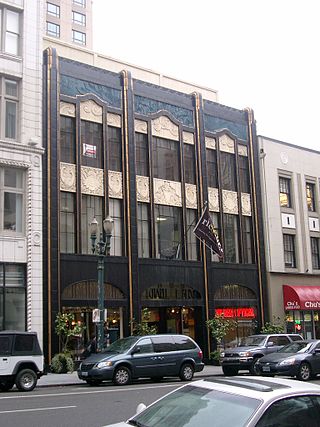
The Charles F. Berg Building, also the Dolph Building is an art-deco building in downtown Portland, Oregon. It is one of the few examples of commercial use of art-deco in Portland.

The Ladd Carriage House is a building in downtown Portland, Oregon, at Broadway and Columbia. It is one of the few surviving buildings forming part of the former grand estates which once stood in the downtown core. It is listed on the National Register of Historic Places.

The Kimpton Hotel Vintage Portland, historically known as the Imperial Hotel and also as The Plaza Hotel, is a historic hotel building in downtown Portland, Oregon, United States. It was completed in 1894 and was listed on the National Register of Historic Places in 1985 as "Imperial Hotel". Since 2015, the building has been in use as the Kimpton Hotel Vintage Portland, and prior to then it had been known as the Hotel Vintage Plaza since 1991.

The Telegram Building is a historic building in Portland, Oregon. It was constructed in 1922, several years after The Evening Telegram newspaper had been purchased by John E. and L. R. Wheeler. The Telegram was a newspaper founded in 1877 by Henry L. Pittock; it merged in 1931 with the Portland News, creating the Portland News-Telegram, which ceased publishing in 1939.
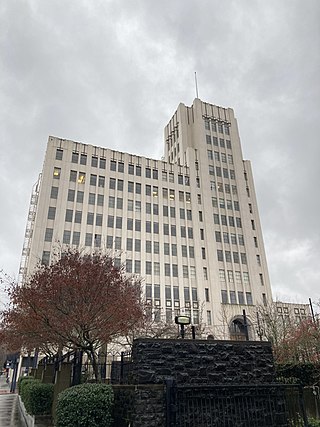
The Terminal Sales Building is an historic building in Portland, Oregon, United States. One of the few pieces of prominent Art Deco architecture in Portland, it is the only high-rise example. While the building's design may be credited to Wilfred Frank Higgins, Mr. Higgins was working under the architect A.E. Doyle, who referred to Higgins as his draftsman. Doyle was so involved with the project, that he continued to direct Higgins even while traveling in Europe, wiring the office instructions on paint specifications.

The Yeon Building is a historic 59.13 m (194.0 ft), 15-story office building completed in 1911 in downtown Portland, Oregon. Almost completely clad in glazed terra-cotta, and culminating in a colonnade on the top floors, the Yeon Building once was illuminated at night by light sockets built into the cornices, but later removed. The building's namesake is Jean Baptiste Yeon (1865–1928), a self-made timber tycoon who financed the construction. At the time of completion, the Yeon Building was the tallest building in Oregon and it remained so for nearly two years.
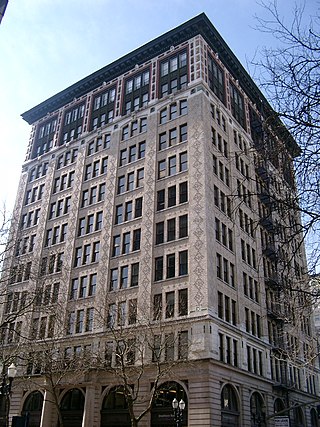
The Wells Fargo Building is a historic office building in downtown Portland, Oregon, United States. The large doorstep at the building's entryway required the largest slab of granite ever shipped to Portland at the time. Completed in 1907, the steel-framed building is considered the city's first true skyscraper. At 12 stories and with a height of 182 feet (55 m), it was the tallest building in Portland, exclusive of towers, and remained so for four years. The clock tower of the 1892-completed Oregonian Building, which measured 194 feet (59 m) in height, made that building the tallest in the city overall.
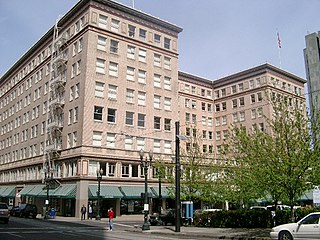
The Pittock Block is a historic building in downtown Portland, Oregon, occupying a city block between SW 9th and 10th Avenues, SW Stark and Washington Streets, and west of O'Bryant Square.

The Spalding Building, formerly the Oregon Bank Building, is a historic office building in downtown Portland, Oregon, United States on the northwest corner of SW 3rd Avenue and Washington streets. Since 1982, it has been on the National Register of Historic Places.

The Hamilton Building is a historic office building in downtown Portland, Oregon. It went through a renovation in 1977, and was listed on National Register of Historic Places in March of that year. It is the neighbor of the Dekum Building, a fellow NRHP listing on Third Avenue.

The Henry Weinhard Brewery complex, also the Cellar Building and Brewhouse and Henry Weinhard's City Brewery, is a former brewery in Portland, Oregon. Since 2000, it has been listed on the National Register of Historic Places. In that same year, construction began to reuse the property as a multi-block, mixed-use development known as the Brewery Blocks.

The Bank of California Building, also known as the Durham & Bates Building and currently the Three Kings Building, is a historic former bank building in downtown Portland, Oregon, United States. It has been on the National Register of Historic Places since 1978. The three-story building was designed by A. E. Doyle in an Italianate style and completed in 1925. The ground floor features a two-story-high grand room with 36-foot (11 m) ceilings. The building's original owner and occupant, the Bank of California, moved out around the end of 1969 and sold the building in 1970. It has had a succession of other owners and tenants since then. It was last used as a bank in 1977.

The Public Service Building is a historic 67.06 m (220.0 ft), 15-story office building in downtown Portland, Oregon, United States. The building and its attached parking garage have been listed on the National Register of Historic Places as the Public Service Building and Garage since 1996. It was built to house the offices of the Portland Gas and Coke Company and the Pacific Power and Light Company. The building's name reflects the fact that these utilities were "public services". A space in the Public Service Building fronting the corner of Salmon and Sixth streets became the first Niketown store.
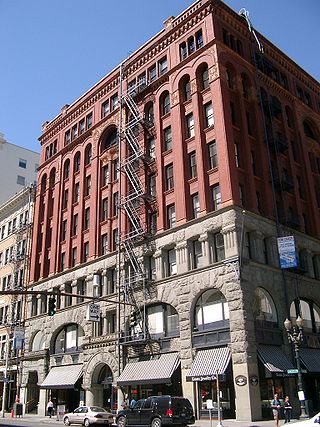
The Dekum or the Dekum Building is a historic office building in downtown Portland, Oregon, United States. It was listed on the National Register of Historic Places in 1980.

The Ambassador Apartments is a historic building in downtown Portland, Oregon, United States. Since 1979, it has been on the National Register of Historic Places.

The Stevens Building is a commercial and office building located in downtown Portland, Oregon, listed on the National Register of Historic Places. The 12-story building was designed by Whidden & Lewis. The design is similar to the Failing Office Building (1907) and Wilcox Building (1911), also by Whidden & Lewis. Construction began in August 1913 and was completed in 1914, with the building opening on May 1, 1914. The total construction cost was $375,000. The building is approximately 152 feet (46 m) tall.

Hamilton Forbush "Ham" Corbett was a prominent Portland, Oregon businessman and in his younger years was a leading amateur American football player. He played college football for Harvard University and was a consensus first-team selection to the 1908 College Football All-America Team.























